Long before the Mistral
Many people know about the Soviet-Italian technical cooperation in the field of military shipbuilding. Its results are also widely reported. This construction of the Italian shipyards for the USSR, the leader of the destroyers Tashkent, which became famous during the war, and help in designing the first cruiser of the Soviet construction Kirov, created on the basis of the theoretical drawing of the Italian Eugenio di Savoy, is also Italian ship propulsion, torpedoes and anti-aircraft guns, which formed the basis of our engines and weapon systems. Much less is known that the Soviet Union initially turned to France for such help. And the likelihood that the Soviet cruisers and leaders would carry in themselves the features of the French ship school, was extremely high. But first things first.
Significant event in stories The Armed Forces of the Soviet Union, and in the thirties, became the plans of the domestic shipbuilding for the second five-year plan. 11 July 1933 g. The Council of Labor and Defense (STO) adopted a decree "On the program of naval shipbuilding at 1933-1938." The country was in full swing intensive reconstruction of old and, the construction of new shipbuilding enterprises, organized new industries. Along with this, the Soviet Union turned to the procurement of modern technologies in the West.
The missions of Soviet engineers and specialists abroad were under the personal control of I.V. Stalin. It was he who at the end of 1933 of the year instructed the narcomenorum K.E. Voroshilov, send our specialists to France to familiarize themselves with the state of the French naval equipment and industry to determine the possibilities and conditions for attracting foreign technical assistance to building ships of the Red Army naval forces.
3 January 1934, Voroshilov ordered the head of the naval shipbuilding department S.A. Sivkov, go 6 January with a group of naval engineers to France.
The group was tasked with finding out the conditions for buying in France a number of models of mechanisms, weapons, optics and communications. In a written order, Sivkov was instructed to familiarize himself "with a personal inspection" with the latest French submarines fleet large tonnage of the type "Agosta", and the average tonnage of the type "Orien", and "Pearl"; with Fantasque leaders, destroyers, Bayonnaise escorters, and cruisers of the latest construction. And also with torpedo boats; samples of the latest marine tools, in particular, anti-aircraft 100 mm, 75 mm and 37 mm; with shells - armor-piercing, landmines, lighting, diving; with torpedoes and mines, paying particular attention to radio-controlled and air torpedoes, as well as mines against lead boats; with hermetic double and triple torpedo tubes for submarines; with communication devices for submarines in the surface position.
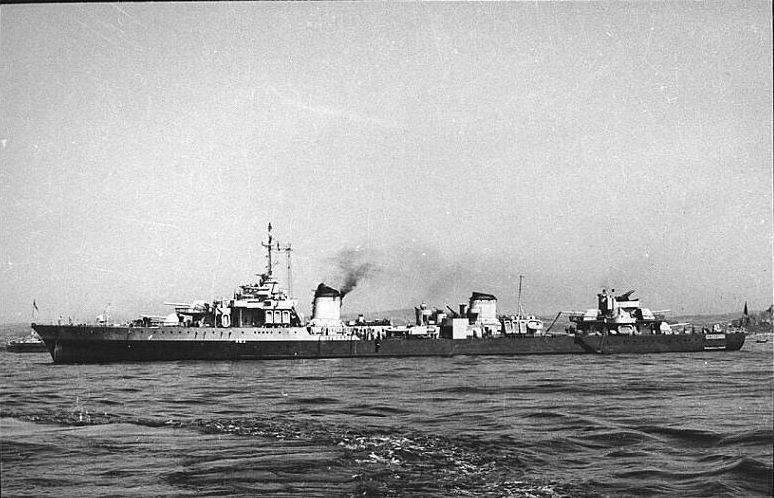
A group of Soviet engineers was to inspect in France: the country's main shipbuilding and engineering factories, in particular, the factories supplying turbines, diesel engines and auxiliary machinery; battery manufacturing plants and long periscopes for submarines; factories producing medium and anti-aircraft artillery and shells; torpedo and mine factories; experience shipbuilding pool.
In the case of a satisfactory assessment of the capabilities of the French naval industry, Sivkov should have requested the following information from the relevant French firms: the conditions for obtaining technical assistance in designing the leaders of the destroyers; technical data and conditions for the purchase of the latest models of batteries and electric motors for submarines; long periscopes for submarines; motors for torpedo boats; torpedo tubes for submarines; anti-aircraft systems; torpedoes and mines; communication facilities; separate ship mechanisms and devices: main turbines and boilers, diesel engines, turbofans, etc.
Already 7 February 1934 was on the table Voroshilov lay a detailed report on the mission of the group Sivkov to France. From the report it was clear that in France were examined: the leaders of the squadron destroyers "Epervier", as well as "Fantasia" and "Odassie"; escorts; torpedo boats type "Vedette"; the cruiser "Emil Berten"; submarine "Conkeran"; rechargeable batteries for submarines and periscopes.
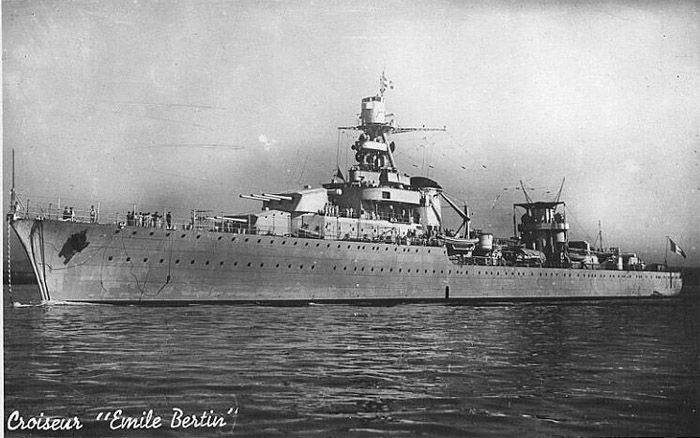
The group inspected shipbuilding and engineering plants. In his report, Sivkov drew certain conclusions. The level of the French naval technology in the part of light and high-speed ships is high and quite modern. French leaders and escorts are great ships, their types are quite suitable. “I consider it necessary,” he wrote, “to purchase from the French technical assistance on leaders in full (drawings, instructions, order in France for the first mechanical installation) and drawings on escorts. The French, shown to us in the field of scuba diving, does not make it possible to draw any reliable conclusions about the level of their submarine technology — more detailed acquaintance with submarines, which should be considered good combat ships, is necessary. "
Sivkov attached to the report a detailed description of the French leaders E'pervier and Fantak, as well as a description of the Conqueran submarine. The report shows that Sivkov considered the most successful and modern ships of the French fleet leaders and escorts and offered to buy technical assistance on building leaders for the Navy Red Army.
13 February 1934. Voroshilov turned to Stalin and Molotov with a request to discuss the issue of obtaining French technical assistance at the next meeting of the defense committee, and also informed them that the Sivkov group that had traveled to France made it necessary to acquire French technical assistance on "Fantasy" leaders and escorts . For greater certainty Voroshilov attached Sivkov report on a trip to France.
Having received a principled "welcome" from the country's leaders, Voroshilov the very next day, February 14 1934 wrote a note to Stalin asking him to give orders to the Commissar for Foreign Affairs Litvinov about a special letter to the French Government.
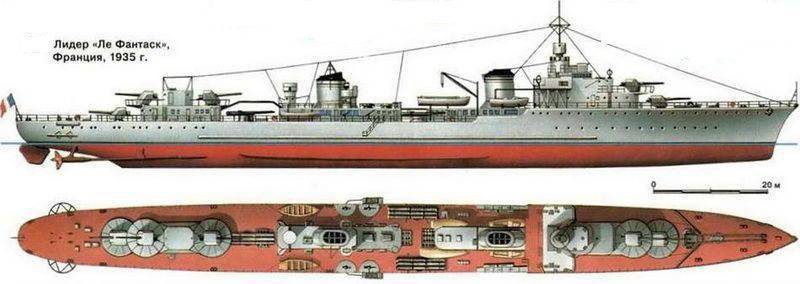
If the purpose of the group’s mission under Sivkov’s leadership was to familiarize with the French industry and “explore” the possibilities of cooperation with the French in the field of naval construction, the next group of engineers led by Muklevich, the Chief Shipbuilding Industry Directorate, was sent to France to negotiate with the maritime ministry and drafting an agreement on French technical assistance.
Muklevich's group was in France from April 15 to 26 in May 1934. During this period, Soviet engineers examined the 10 shipbuilding and engineering plants and the ships under construction on them, especially the leaders and the escort of the French military fleet. Muklevich even managed to go to sea on the Epervier leader.
The group collected material on the design and cost of ships of interest to the Soviet command, as well as on the equipment of shipyards. Muklevich received the consent of the maritime ministry and firms to supply the Soviet Union with the main mechanisms identical to those under construction for the French navy and the projects of the escort leader, slightly different from the French prototype. In addition, Muklevich agreed on the principle agreement on the provision of technical assistance to our fleet for the development of the first ships and mechanisms.
7 June 1934 was adopted by a decree of the Council of Labor and Defense of the USSR, in which the trade representative in France was instructed to continue the negotiations begun by Muklevich. It was pointed out that it was necessary to prepare the ground for the representatives of the company to come to Moscow with whom an agreement would be concluded.
The resolution specified the maximum price for the supply of mechanisms, drawings and technical assistance for the leader - 3,5 million rubles and for the escort - 1,5 million rubles. Responsibility for negotiations with firms in France was assigned to the trade representative Ostrovsky, and in Moscow - to Muklevich.
In accordance with this decree of the USSR STO, negotiations on French technical assistance on the leader and escort were conducted at the first stage in Paris during the summer 1934 of the year by the trade representative of the USSR in France Ostrovsky with two groups of companies:
1. Shipbuilding company "France" and related to it, the turbo-building company "Fives-Lille", which built Parsons turbines.
2. By the firm "Penoet" and "Brittany", which built the turbines "Rato".
Engineer Alyakrinsky was assigned to assist the trade representative on technical issues by the Naval Forces Directorate. Negotiations with the first group of firms took place favorably due to the fact that the trade mission in France focused on these firms in advance, having with them a number of cases in the past, and considering them to be quite reputable, and also because of the greater initiative of the French firms that did not require government loan guarantees and declared a lower price (49,5 million francs - about 3,8 million rubles). Therefore, in the summer of 1934, in Paris, definable agreements were reached in France with France and Thebes-Lille.
Negotiations with a group of companies "Penoet-Brittany" proceeded much harder. The main difficulty was the disagreement of the French on the provision of a loan without guarantees from the Paris government and the higher price claimed by these firms (55 million francs - about 4,1 million rubles).
Representatives of France and Thebes-Lille were invited to the Soviet Union. In the period from 9 to 22 September 1934, Glavmorprom together with the French representatives discussed technical requirements and issues of industrial technical power. During these negotiations, agreement was reached on the following issues:
1. Providing Soviet naval engineers with access to production details at French factories.
2. Obtaining all the necessary data for the production of individual mechanisms in the USSR and their parts before forgings and castings, inclusive.
3. Assistance in the production of turbine blades.
4. Receipt of calculated data and methods of calculation for the main mechanisms.
Representatives of the firms could not answer some of the requirements of the Soviet side and left to study them in France. Already in October, France and Fives-Lille, 1934, sent their conclusions from France on all the issues under consideration, and they agreed to accept all the demands of the Soviet side.
17 December 1934, the head of the Red Forces Marine Forces Department, Orlov, addressed to the People’s Commissar of Defense, presented a detailed report on the negotiations with the French, which concluded that Glavmorprom, agreeing with the opinion of the USSR Trade Mission in France, suggested concluding an agreement with group of companies "France-Fiv-Lille".
29 December 1934 of the year was adopted by the Resolution of the USSR STO, which said: "Approve the choice of the company" Shantier de France "and" Thebes-Lille "to enter into an agreement with them on technical assistance on the leader with the Parsons turbines and guaranteed 39 average speed nodes with eight-hour testing and 41 node at full capacity within one hour. Increase the limit on the costs of the contract to 4,8 million rubles, including in this amount the costs of transport, credit, additional equipment, etc. People’s Commissar of Heavy Industry (t . Ordzhonikidze and Muklevich) to prepare the construction of the two leaders of French drawings by providing, within two months of the conclusion of the contract the courts of construction plan. "
Everything, as we see, was developing quite successfully, but in February 1935goda, while signing a contract for building a leader and technical assistance, representatives of the companies "Chantier de France" and "Thebes-Lille" unexpectedly announced new conditions for paying for the construction of a leader in the amount of 57 million francs, i.e., 7,5 million more than the price they previously declared. The price increase was motivated by the French, ostensibly, by the increased volume of technical assistance and the need to pay large sums to counterparties for the blueprints of auxiliary mechanisms and devices transferred to the Soviet side.
In the reference report addressed to Stalin and Molotov 28 February 1935, A. Rozenholz (People's Commissar for Foreign Trade) expressed the opinion that we cannot accept the new conditions of the French. He proposed once again to enter into negotiations with the owners of the company themselves, and if within two weeks they did not retreat from their unreasonable demands, then "we should stop completely negotiations on this case with French companies and enter into negotiations with companies from other countries, in particular, Italy or England. "
The head of Glavmorprom Muklevich, in a letter addressed to Ordzhonikidze, said that the Soviet side, considering it necessary to successfully complete the negotiations, went to increase our price by directly raising fees to 49,9 million francs and increasing premiums of about 1 million francs for achieving high speeds, than 39,5 nodes; In addition, for the company’s greater responsibility for technical assistance, the Soviet side offered the French a premium for accepting the same speed guarantees for the second leader with the mechanisms of our construction with French technical assistance, which ensured that they received a premium of about 2,6 million francs (200 thousand gold rubles) for reaching the second leader of speed in the 42 node. However, the French did not show sufficient interest in the proposal of the Soviet side to increase the premium by interrupting the negotiations and left for their homeland.
The behavior of the French delegation was not so inexplicable. The fact is that the sharp turn of the French in terms of price was influenced by the good test results of the leaders of Terribl and Triumph, which showed speed, according to a representative of the firm of engineer Gardy, during the eight-hour test of 42,5 nodes (Terribl) and 41,5 nodes (Triumphant "). The Soviet delegation could not go on further price increase, seeing no reason for this and without authority.
The head of Glavmorprom offered to finally clarify the position of the Shantier de France and Thebes-Lille firms, the reasons for the sudden price increase and the possibility of concluding an agreement on the terms we proposed, and to resume negotiations with the head of the other competing firm Brittany and Penoet. Fuld based on the contract developed in Leningrad and go for a possible price increase for obtaining the Rato turbine plant and technical assistance, but not higher than the price previously announced by this company - 55 million francs (4,2 million gold rubles).
If it is impossible to achieve positive results with French companies in the near future, Muklevich suggested starting negotiations on technical assistance on leaders with Italian companies.
20 May 1935 STO USSR approved the proposal Muklevich. And on April 28, 1935, the head of the Directorate of the Naval Forces of the Red Army, Orlov, wrote a letter to the USSR People's Commissar of Defense K.E. Voroshilov, in which he reported that he had already personally reported to him about the advisability of attracting Italians to technical assistance on leaders. Orlov believed that the Italians could give us a ship, which in its tactical and technical elements was not inferior to the French.
In addition, cooperation with the Italians allowed for the price that the French demanded only for one mechanical installation, to get in Italy, in addition to technical assistance, a whole ship. In view of the fact that a ship with the participation of Italian technical assistance was supposed to be built according to a specially designed project and drawings for us, Orlov considered it necessary to order the first ship in Italy.
Thus, the Soviet leadership, having encountered obstacles with the conclusion of a contract on French technical assistance, despite the extensive preparatory work that had been carried out, decided to promptly switch to negotiations with Italian firms.
Already 20 in July 1935, Voroshilov reported to Stalin and Deputy Chairman of the USSR STO Chubar that, pursuant to the STO, negotiations had been started with Italian companies on the order of the leader with elements not lower than the French leaders of the Triumph type.
As for the French technical assistance to the leaders, a reference was written by NPO Voroshilov about supplying French companies for us with a machine-boiler installation for the leader of the destroyers without installation on the ship and without drawings worth 47300 000 francs (3,55 million rubles), as well as drawings of the hull of the leader in the amount of 3800000 francs (285 thousand rubles).
7 September 1936, on the eve of the signing of the contract with the Italians for the construction of a squadron destroyer, put the message from the authorized NGO Gittis on the table of the Deputy People’s Commissar of Defense of the USSR Tukhachevsky, in connection with the renewed negotiations on the trade and financial agreement with France demanded urgently a certificate of the objects of interest to NCOs.
The objects we urgently needed at the moment were ordered for the acquisition in France. In particular, for naval needs, floating docks 2000-3000 and lift forces — 2 units were urgently purchased; 7000 floating workshop with displacement with full equipment - 1, sea tugs 800-1000 hp - 10; oil transports 3000 t - 2; oil transports 1000-2000 t - 1; floating cranes 200 tons of capacity - 2; 50 T - 4; 10 t -10; petrol barges -2; Nautical boats 30-50 T - 15; power boats petrol 100 HP - 50; by 250-300 hp - 50; diesel light on 50 hp - 30; by 150 hp - 30; anti-torpedo networks - 5 miles.
Thus, the Soviet Union made active attempts to use the naval achievements of industrialized countries, in particular France. But due to various technical and financial reasons, France did not become a major supplier of its naval experience for the USSR, such as Germany or Italy. However, in the mid-thirties, during the period of political warming of relations between our states, the military leadership of the Soviet Union attempted to use the technical achievements of France to strengthen the Red Army Navy.
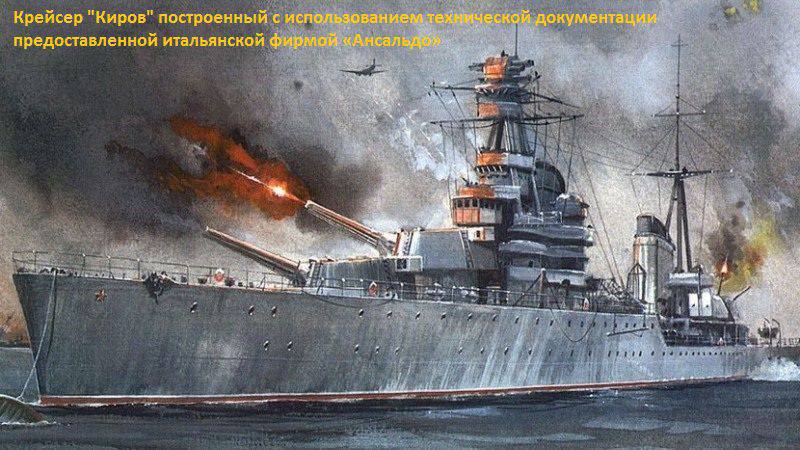
Sources:
Fedulov S. Soviet-French military-technical cooperation in the field of shipbuilding and armament in the 1930-ies. Tambov: Diploma, 2014. C. 170-174.
Kachur P., Maureen A. Leaders of destroyers of the Navy of the USSR. SPb .: ISLAND, 2003. C. 33-35.
Kalinin A. Fail Transaction // Sea Collection. 2003. No.3. C.79-83.
Patyanin S. Leaders, destroyers and destroyers of France in World War II. SPb .: Publication of the almanac “Ships and battles”, 2003. C. 30-32.
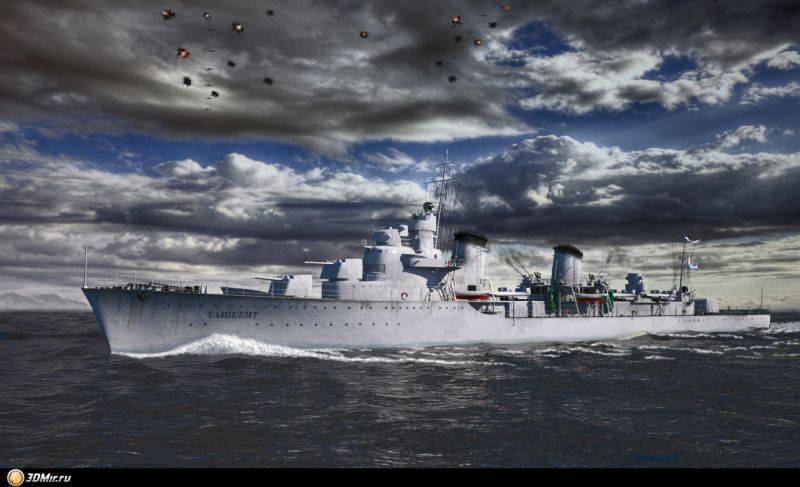
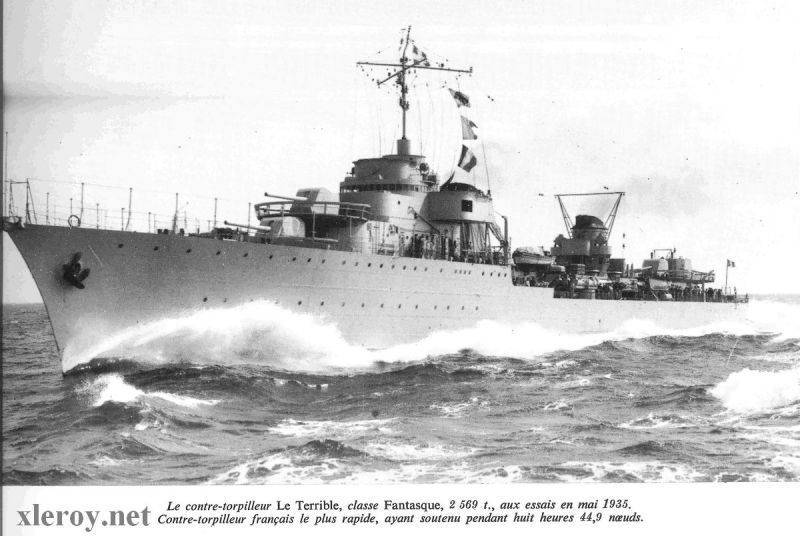
Information